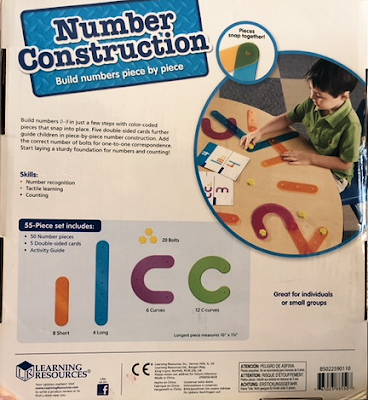 |
Number Construction |
In the box: 50 number pieces, 5 cards
Number Construction reminds me of the Handwriting Without Tears (HWT) program, but it is NOT a HWT product. I am a huge fan of HWT and used it exclusively when I was a school OT. It's a great program, especially for kids who have trouble with visual perceptual skills. One year I even did a whole-class session in a self-contained room four days a week, and by the end of the year everyone was writing legibly. The teacher later told me that there were several older kids in the class that she didn't think would ever learn to write. I have several HWT products but have not blogged about them yet, but will. So much for my plug for HWT. This activity is not a HWT product and does not exactlymatch the HWT numbers for shapes.
This activity includes four different shaped hard, plastic pieces that will be used to build the numbers. Each of the four pieces are a different color (blue, purple, green, orange). The yellow bolts are used for counting, not constructing, and are made from a rubbery plastic material. You could also place them on the numbers in the positions that you would use to teach Touch Math, another program that I have used many times successfully when teaching money skills. There are not enough pieces to make all the numbers at the same time.
The five double-sided cards show numbers from 0 - 9. Each side shows one number. The top of the card shows the pieces you will need to construct the number and the bottom shows the finished number. The yellow bolts can then be used as manipulatives to count out the number. JMHO.
 |
| Back of the box. |
 |
| Construction cards. |
Try this:
- Work
on visual discrimination, spatial relations, visual form constancy,
visual closure, eye-hand coordination, manual dexterity, coordinated use
of both hands, Touch Math, numbers 0-9, executive functioning skills,
process skills, play and leisure exploration and participation




